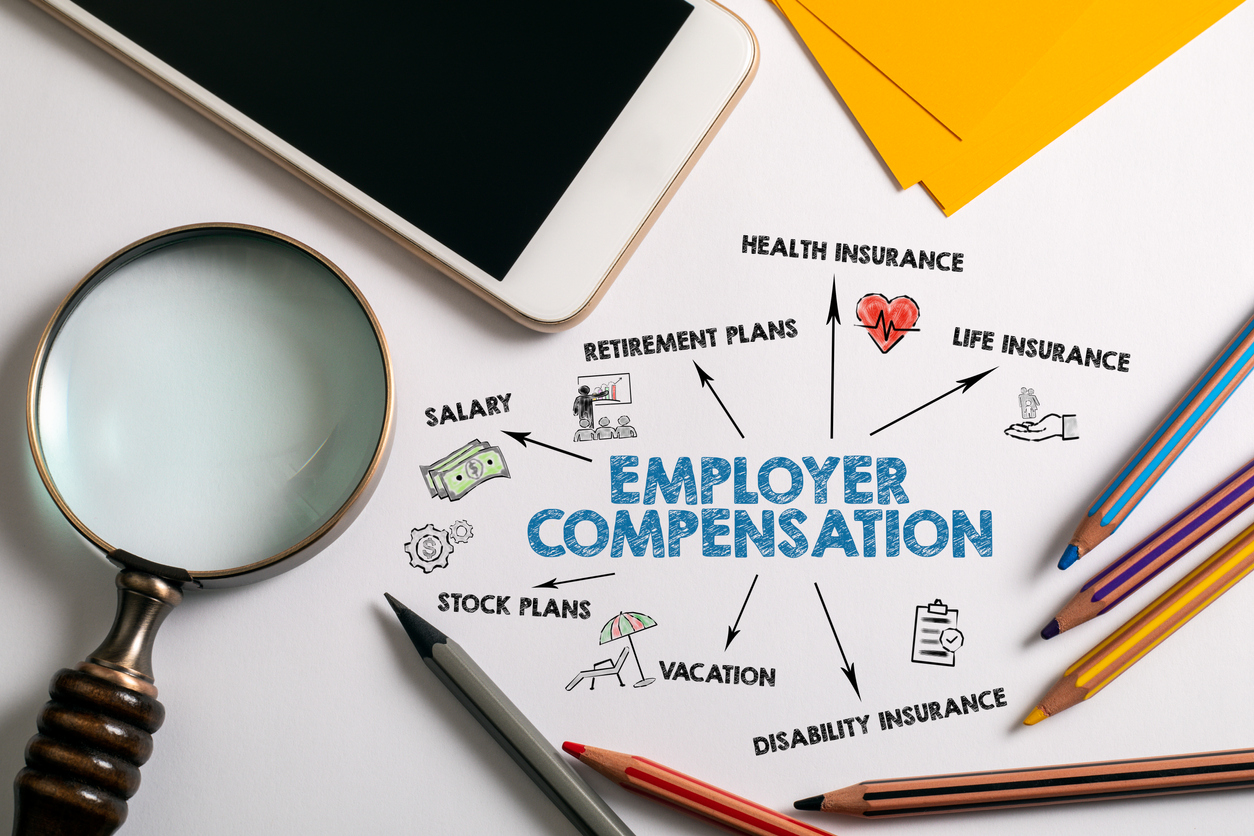
Written by
Aidan Farrish
Aidan is an aPHR-certified writer on the marketing team at BerniePortal. She writes about HR, healthcare, and benefits.
What Are the 4 Pillars of a Total Rewards Strategy?

Have you ever worked for an employer that provided health insurance coverage? Or maybe you participate in an employer-sponsored program that promotes upskilling by letting you earn certifications or receive training. Perhaps you’ve attended a holiday party!
These are all examples of total rewards: the specific offerings from employer to employee that contribute to employee satisfaction and increase overall organizational value. A comprehensive and competitive total rewards package that features something from each of the four “pillars,” or categories, has many positive impacts on your organization, like improving recruitment and retention.
However, total rewards aren’t cut and dried—there are many factors that affect the four “pillars” of total rewards, and what works for one company may not work for another. So let’s define total rewards, and take a deep dive into the four pillars and some of their subcategories.
What Are Total Rewards?
Total rewards are all the things an employee receives due to working at your organization. Here are some rewards you may recognize:
- being paid a salary or hourly rate, or compensation
- receiving benefits like health insurance or PTO, or benefits
- participating in career development, like earning certifications, or development
- attending company-sponsored events or activities, or wellbeing
Total rewards are a great way to align employees with an organization’s values, which can build a cohesive brand identity and develop a more connected workforce. If you’re an HR professional, you can begin thinking about a total rewards package that aligns with your company by first understanding the four “pillars” of total rewards.
You may be wondering how each of these factors impacts total rewards. Many people think of total rewards as just paychecks or health insurance, but they encompass much more than cash-in-pocket offerings. There is much more room for creativity if you’re willing to think outside the box.
The 4 Pillars of Total Rewards
The four pillars of total rewards are compensation, benefits, development, and well-being. They can be broken down further to help you define how each factor affects the overall total rewards strategy. Let’s take a look:
.png?width=1049&height=1049&name=Pillars%20of%20Total%20Rewards%20(1).png)
Each pillar of total rewards contains many different facets of that category. There are many ways your organization can integrate various options within each pillar into your total rewards strategy. If you have a robust sales team, commissions may be a great way to show recognition of their efforts and compensate them appropriately according to their successes. If your organization is within an industry that has many specialties, you may want to consider offering opportunities for employees to earn licensing or experience in niche parts of their field that they lack access to.
Let’s look at our organization, BerniePortal, for examples of how each pillar may be reflected within a total rewards package.
For the compensation pillar, we provide success shares to teams that meet quarterly goals. This not only encourages everyone to achieve, but also shows that the success of our organization is directly tied to the efforts of each individual contributor, and so they are included in the overall success.
Success shares are a great way to incentivize people to work harder and build a culture where everyone’s goals are aligned with the growth of your business.
For an example of the benefits pillar, we enjoy the generous benefit of uncategorized PTO, which helps us take time off as needed without worrying about defining sick days versus vacation time. Exempt employees also have unlimited PTO, which provides a strategic opportunity for employees to budget their time and workload wisely to take advantage of time off whenever they desire. These benefits have proven to be a competitive advantage when recruiting in a tight labor market.
While uncategorized and unlimited PTO work for us, they may not work somewhere else. Total rewards look different for every organization. They are dependent on the values a company promotes, as well as other key aspects of company culture, mission, origins, location, and more.
For the development pillar, BerniePortal enjoys a strong culture of mutual respect and transparency, so one of our total rewards strategies is to promote internally whenever possible, so driven individuals may have a chance for career advancement within our organization.
This doesn’t apply in every case—for some specialist or leadership positions, we rely on external candidates. However, we always give specific reasons as to why an external applicant is being sought. By promoting career advancement internally, we provide employees with reasons to upskill themselves and seek opportunities to strengthen their involvement in our organization.
For the wellbeing pillar, we show everyone how we value being part of our community. Therefore, we provide opportunities for those with a shared interest to participate in our partnerships with Big Brothers Big Sisters of Tennessee and the Best Buddies program. These partnerships are considered our “Circle of Influence” program and align closely with the values our organization engenders. For involved employees, we provide a generous stipend to fund their activities with the people they mentor through the Circle of Influence programs.
Keep in mind that if you do provide opportunities for volunteer work or other kinds of community outreach, assure everyone that it’s not required to participate.
The options are endless, and you are best equipped to know what will work well for your organization. You work with your health insurance broker to find the best benefits for your workforce, but you also have the holistic perspective to make decisions with the budget and future goals of your organization in mind.
As an HR professional, you know the ins and outs of your organization, and you also act as an advocate for your employees. Ensuring your total rewards strategy reflects the interests and needs of your workforce, tempered by your perspective of business needs and goals, will help you improve the employee experience and increase organizational value overall.
Additional Resources
You can stay informed, educated, and up to date with important HR topics using BerniePortal’s comprehensive resources:
- BernieU—free online HR courses, approved for SHRM and HRCI recertification credit
- BerniePortal Blog—a one-stop shop for HR industry news
- HR Glossary—featuring the most common HR terms, acronyms, and compliance
- Resource Library—essential guides covering a comprehensive list of HR topics
- HR Party of One—our popular YouTube series and podcast, covering emerging HR trends and enduring HR topics

Written by
Aidan Farrish
Aidan is an aPHR-certified writer on the marketing team at BerniePortal. She writes about HR, healthcare, and benefits.
Related Posts
Part-time work is becoming increasingly common in today’s workforce—especially for...
As an HR professional, you’re responsible for helping employees navigate their health...
Healthcare access has become a major priority for employers—and employees—over the past...
Summer is synonymous with vacations, PTO, and out-of-office messages—but it’s also the...








Submit a Comment